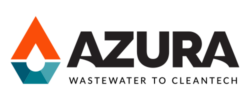Azura’s experience with food waste anaerobic codigestion (AnCoD) and our work at energy producing biogas plants was the basis for one of two podium presentations scheduled for the 2020 WEAO conference. Due to the COVID-19 pandemic, the in-person conference and presentations were cancelled, luckily the papers were still published.
The Water Environment Association Ontario (WEAO) is the leading association of wastewater professionals in Ontario, Canada. With more than 1,200 members, this regional chapter of the international Water Environment Federation (WEF), supports the industry by providing connection and networking opportunities for wastewater experts and novices alike, publishing a high-quality technical magazine, and organizing events with expert technical content.
The annual WEAO conference and technical exhibition is the premier wastewater-focused event in Ontario, where wastewater subject matter experts gather and share the latest information in the water environment field. The 2020 conference was scheduled for April 2020, although the in-person event was cancelled due to the COVID-19 pandemic.
The paper titled “Experiences and Lessons from Three Years of Involvement and Operating Data of Energy Digesters in Ontario” was authored by Azura’s Dodge Yu and David Ellis. Adapted from the Abstract:
More than 30 waste-to-energy digesters are currently operating across southern Ontario to produce biogas and renewable energy. Most of these digesters are on-farm installations that anaerobically codigest (AnCoD) food waste and other off-farm organic wastes with manure. Examples of the off-farm organics that these digesters receive are high-strength organic wastes from food manufacturing plants, grease trap clean-outs, spoiled food products, by-products from organic chemical manufacturing, and other biodegradable organic wastes.
Currently, there is a lack of information in the literature detailing Ontario’s experiences with the highly variable organic wastes directed to these waste-to-energy (WTE) biogas facilities. As such, operating these biogas energy digesters resulted in several learning experiences for the digester operators. Many practical operating lessons as well as design considerations for future AD projects were learned over the last few years. Extensive operating and laboratory testing data was also collected during this time. Discrepancies were noted between the inhibitory concentration of some parameters reported in the literature and the observed experiences with full-scale digesters. Additional sources of inhibition that were not previously considered were also observed.
The lessons and experiences portion of the presentation began by presenting background information about Ontario’s biogas energy digester plants. The codigesting nature of these plants, combining manure and organic wastes, make these facilities unique as no two biogas plants in Ontario receive exactly the same blend of feedstocks. Therefore, the operating experiences and lessons learned by the operations staff at these biogas plants differ from accepted literature values reported at other codigestion biogas sites.
The paper is broken down into three main topic areas: feedstock receiving and storage, digester operation and monitoring, and digestate management.
Azura saw some digesters were faced with challenges around feedstock receiving. The waste nature of the feedstock resulted in the materials being quite variable, having significant heterogeneity, and causing both physical and chemical issues with the feedstock storage systems at the biogas plants. Common challenges around feedstock foaming and obstruction from physical debris are common points requiring increased attention from operators and designers.
There are many common parameters that digester operators analyze to maintain optimal anaerobic digester performance and biogas production. The mechanics behind parameters such as FOS/TAC (analogous to VA/BA and Ripley Ratio), pH, and ammonia-nitrogen inhibition are well understood in literature. However, we noted several occasions where anaerobic digesters displayed stable operation at pH and ammonia levels outside the text-book recommended ranges.
Azura also explored parameters that were not well studied in literature. The noteworthy parameters include the speciated volatile fatty acids (VFAs) and speciated long-chain fatty acid (LCFA) concentrations. VFAs have been well-studied in the literature, however there is less data available on LCFA inhibition. Many of the LCFA-related anaerobic digestion studies are limited to lab-scale testing with only a few specific LCFA forms studied at one time. Using years of LCFA data collected from full-scale digester sites, we are now able to work with operators to establish operating guidelines for anaerobic digesters with a high FOG feedstock blend.
The debris and contaminants that enter the biogas digesters with the feedstock can be issues for digestate management following digestion. All the anaerobic digester biogas facilities in this study ultimately apply the finished digestate material to agricultural lands. Some locations apply the digestate slurry and some use solid-liquid separation machinery to recover undigested fibre for re-use as livestock bedding and land applying the watery filtrate. In both cases, digester owners have noted non-digestible contaminants such as plastics either on the land or in the separated animal bedding. The plastic contaminants can cause issues in both farming practices and livestock operations. This contamination highlights the importance of reducing trash and other tramp material at the beginning of the digester process train, as well as the emerging issue of a consistent digestate quality standard.
For more information about WEAO and the annual conference, please visit them here: WEAO
Get Insights from the Bioprocess Experts Right to Your inbox
Sign up to the Discover Digesters Newsletter to access Azura’s best practices, field-tested advice, and insights into the anaerobic digestion & industrial wastewater treatment industries.
By submitting this form, you are consenting to receive marketing emails from: Azura Associates. You can revoke your consent to receive emails at any time by using the SafeUnsubscribe® link, found at the bottom of every email. Emails are serviced by Constant Contact.

